See also
- Claymore (disambiguation), for other ships
A number of motor vessels that have used the ship prefix M/V have been named Claymore, including:

Caledonian MacBrayne, usually shortened to CalMac, is the major operator of passenger and vehicle ferries, and ferry services, between the mainland of Scotland and 22 of the major islands on Scotland's west coast. Since 2006, the company's official name has been CalMac Ferries Ltd, although it still operates as Caledonian MacBrayne. In 2006, it became a subsidiary of holding company David MacBrayne, which is owned by the Scottish Government.

The Caledonian MacBrayne fleet is the largest fleet of car and passenger ferries in the United Kingdom, with 34 ferries in operation, 2 on charter and another 6 on order. The company provides lifeline services to 23 islands off the west coast of Scotland, as well as operating routes in the Firth of Clyde.

MV Lord of the Isles is one of the larger Caledonian MacBrayne vessels and operates from Mallaig on the west of Scotland. Built in Port Glasgow, she is the most-travelled vessel in the CalMac fleet.
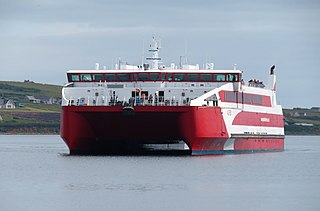
Pentland Ferries is a privately owned, family company which has operated a ferry service between Gills Bay in Caithness, Scotland and St Margaret's Hope on South Ronaldsay in Orkney since May 2001. The company is one of only two major vehicle ferry operators plying within Scotland which are not subsidised by the Scottish Government or local authorities.

MV Hebrides is a ferry operated by Caledonian MacBrayne from Uig to Lochmaddy and Tarbert, the main settlements of North Uist and Harris respectively.

MV Isle of Arran is a drive-through ferry operated on the west coast of Scotland by Caledonian MacBrayne. Entering service in 1984, she served on the Arran route for nine years before being moved to Kennacraig. She returned to her original route in 2012, supplementing MV Caledonian Isles in summer and becoming a relief vessel in winter. In 2013, she started a new pilot route from Ardrossan to Campbeltown, which became a permanent fixture in 2015. As of 2023, she is one of the oldest vessels in the fleet, having been in service for 39 years.

MV Jupiter was a passenger and vehicle ferry in the fleet of Caledonian MacBrayne in the Firth of Clyde, Scotland. She was the oldest of three "streakers" and the third River Clyde ship to bear the name 'Jupiter'. Her open car deck was accessible by stern and side ramps ro-ro. She entered service in 1974, and operated the Gourock to Dunoon crossing for much of her career. In 2006, she became the oldest vessel in the CalMac fleet and continued in service with them until 2010. Jupiter was sold for breaking in 2011.

MV Claymore was a car and passenger ferry built in 1978 for Caledonian MacBrayne. For ten years, she operated between Oban and the Outer Isles. Between October 2002 and March 2009, she was the Pentland Ferries relief vessel on the Short Sea Crossing to Orkney. Since March 2009, she has operated, as MV Sia, a RORO cable-laying and supply vessel. During 2022, the vessel was renamed to MV Ocean Link.

MV Pioneer is a stern / side loading ferry built in 1974, in service for 29 years covering nearly all of Caledonian MacBrayne's routes. She now serves the islands of São Tomé and Príncipe in the Gulf of Guinea and was chartered to rescue Liberian refugees.

MV Orion is a ro-ro passenger and vehicle ferry. Saturn was operated by Caledonian MacBrayne in the Firth of Clyde in Scotland between 1978 and 2011, for the first decade of her career on the Rothesay crossing. Later, she also saw service on the Dunoon and Brodick crossings, as well as on short cruises around the Clyde.
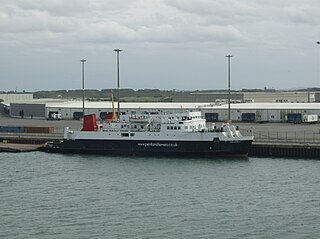
MV Pentalina-B was a ferry which operated on a variety of Scottish routes. Launched in 1970 as MV Iona, she was the first drive-through roll-on/roll-off ferry built for the David MacBrayne fleet. She was the first ship in the company's history to have bridge-controlled engines and geared transmission, rather than direct drive. During her career she inaugurated more endloading linkspans than the rest of the fleet put together. Purchased by Pentland Ferries in 1997, she was renamed MV Pentalina-B and operated across the Pentland Firth until the arrival of their new vessel. In 2009, she was sold to a Cape Verde owner.
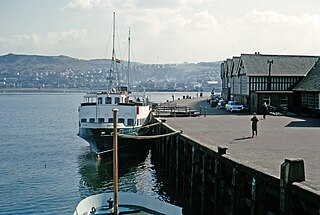
MV Maid of Argyll was a passenger ferry operated by Caledonian Steam Packet Company, initially based at Craigendoran. Rendered redundant by the car ferry revolution, she was sold to Greek owners in 1975. She caught fire in 1997 and was left to decay.

David MacBrayne is a limited company owned by the Scottish Government. Formed in 1851 as the private shipping company David Hutcheson & Co. with three partners, David Hutcheson, Alexander Hutcheson and David MacBrayne, it passed in 1878 to David MacBrayne.
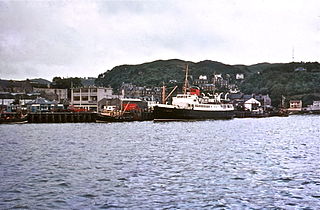
MV Claymore (II) was David MacBrayne's last mail boat built in 1955. She served on the Inner Isles Mail on the west coast of Scotland until 1972. Subsequently sold for day cruising in the Greek Islands until 1993, she sank at her mooring in 2000.
MV Lochearn was a mail steamer operated by David MacBrayne from Oban to Barra and South Uist from 1930 until 1955. She then became the Sound of Mull mail steamer until 1964, when she was superseded by a new generation of car ferry and sold for further service in the Greek Islands.

Caledonian Maritime Assets Limited owns the ferries, ports, harbours and infrastructure for the ferry services serving the west coast of Scotland, the Firth of Clyde and the Northern Isles.
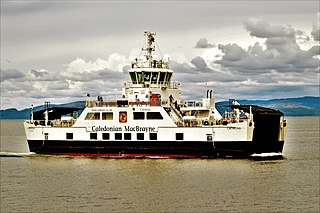
MV Catriona is a pioneering diesel electric hybrid passenger and vehicle roll-on, roll-off ferry built for Caledonian MacBrayne for the Claonaig–Lochranza crossing. She is the third hybrid ferry commissioned and owned by Caledonian Maritime Assets, one of three such ferries in the world to incorporate a low-carbon hybrid system of diesel electric and lithium ion battery power. The ferries are sea-going and are nearly 46 metres (150 ft) long, accommodating 150 passengers, 23 cars or two HGVs.
MV Claymore is a roll-on/roll-off vehicle and passenger ferry currently under construction for use on Caledonian MacBrayne routes on the west coast of Scotland. She is the third of four ferries being built at Cemre Shipyard in Turkey for Caledonian Maritime Assets Limited, and is expected to be delivered in June 2025 for service on the "Uig Triangle" routes linking Tarbert in Harris and Lochmaddy in North Uist with Uig in Skye.
MV Lochmor is a roll-on/roll-off vehicle and passenger ferry currently under construction for use on Caledonian MacBrayne routes on the west coast of Scotland. She is the fourth of four ferries being built at Cemre Shipyard in Turkey for Caledonian Maritime Assets Limited, and is expected to be delivered in October 2025 for service on the "Uig Triangle" routes linking Tarbert in Harris and Lochmaddy in North Uist with Uig in Skye.
A number of motor vessels have been named Lochmor, including